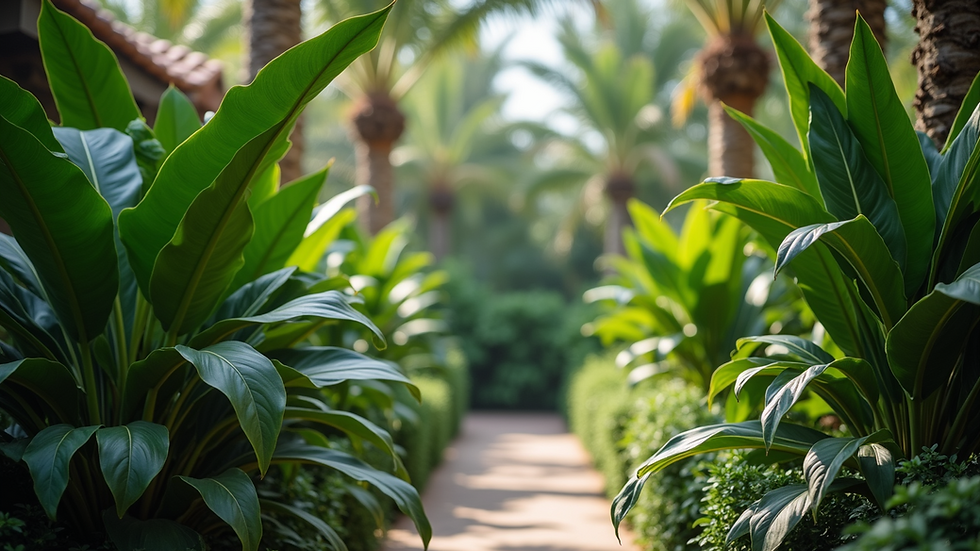How to Keep Your Palm Trees Healthy and Thriving
- Brandon Hall

- May 12
- 4 min read
Palm trees are a tropical delight that brings a sense of paradise to any landscape. Whether you're a seasoned gardener or a novice, keeping your palm trees healthy is both a rewarding and fulfilling endeavor. In this guide, we will explore essential tips for palm tree care, which will help ensure that your beloved palms thrive for years to come.
Understanding Palm Tree Basics
Palm trees come in a variety of shapes and sizes, making them adaptable to diverse environments. Most commonly, they are categorized into two main groups: fan palms and feather palms. Fan palms have leaves that spread out like a hand, while feather palms have long, feathery fronds that cascade downwards. Understanding the specific type of palm you own is the first step in ensuring proper care.

Palm trees are generally resilient but need specific care to flourish. Factors such as soil type, sunlight, and climate play a crucial role in their growth. For instance, some palms thrive in full sun, while others prefer shadier spots. Additionally, understanding the correct watering regime is vital—too much or too little water can harm your palm trees.
Essential Palm Tree Care Tips
Caring for your palm trees involves several key elements. Let's break these down into manageable and actionable steps.
1. Proper Watering Techniques
Watering is perhaps the most critical part of palm tree care. Palm roots are sensitive, and their ability to absorb moisture varies based on the season and region. A good rule of thumb is to check the top inch of the soil. If it feels dry, then it is time to water. It’s important to ensure that you don’t overdo it; excessive watering can lead to root rot.
For in-depth tips on watering palm trees, consider the climate in your area. In hot, dry climates, palms may need more frequent watering, while in cooler climates, you can cut back. Generally, watering should be done deeply but infrequently to encourage healthy root growth.

2. Nutritional Needs
A regular fertilizer schedule is essential for maintaining the health of your palm trees. Fertilizers rich in potassium, magnesium, and iron are particularly beneficial. Look for a slow-release, palm-specific fertilizer that can sustain your trees over time.
It is generally advisable to fertilize twice a year—once in spring and once in late summer. When applying fertilizer, carefully follow the instructions on the package to avoid burning the roots.
3. Should I Cut Off Brown Palm Leaves?
Yes, you can remove brown palm leaves, but it should be done thoughtfully. Brown fronds can occur for various reasons, including nutrient deficiencies or environmental stressors. However, if the leaf is entirely brown and no longer serving its purpose, it’s best to remove it to encourage healthy growth.
To trim palm trees, use sharp, clean pruning shears. Always cut close to the trunk without damaging surrounding leaves. This practice not only improves aesthetics but also allows the tree to focus its energy on healthy fronds.

4. Pest and Disease Management
Unfortunately, palm trees are susceptible to various pests and diseases. Common culprits include spider mites, mealybugs, and palm weevils. Regularly inspect your trees for signs of infestation, such as yellowing leaves, webbing, or holes in the trunk.
If you notice any issues, act quickly. Use insecticidal soap or neem oil to deter pests. Always follow the product instructions and monitor your palm for any adverse reactions. Additionally, maintaining good airflow around your palm trees can prevent many diseases.
5. Climate and Location
The climate where you live plays a significant role in your palm tree care routine. Palms are typically more suited to tropical and subtropical climates. If you live in a colder area, consider planting varieties that are more tolerant to freezing conditions, such as the Windmill palm or the Needle palm.
Moreover, location consideration is key. Planting palms near structures that provide shade can help in hotter climates, while ensuring they have ample sunlight is vital. Understanding your local climate will allow you to provide better care for your palm trees.

Creating an Ideal Environment
Lastly, you must promote an ideal environment for your palm trees. Adequate space for growth is critical, so ensure that the trees are not overcrowded. Additionally, mulching around the base can help retain moisture and regulate soil temperature.
Be mindful of surrounding vegetation that could compete for nutrients. Regularly aerate the soil around your palm, especially if it tends to be compacted. A well-maintained garden bed promotes better health and vitality for your trees.
The Importance of Regular Maintenance
In the end, maintaining healthy and thriving palm trees requires consistent attention and care. Regular checks on their growth and well-being will allow you to catch any problems early before they escalate. Remember that healthy palm trees not only enhance the beauty of your landscape but also contribute positively to the environment.
By following the tips outlined above, you can create a nurturing environment for your palm trees and help them thrive in their natural splendor. From proper watering techniques to understanding nutritional needs, every action you take will yield positive results and bring you closer to enjoying your own little piece of paradise.
Incorporating these practices into your gardening routine will not only protect your investment but also provide you with immense satisfaction as you watch your palm trees flourish. Happy gardening!









Comments